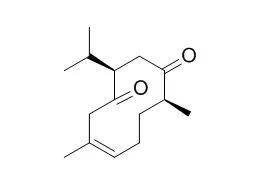| In vitro: |
| Evid Based Complement Alternat Med. 2013;2013:257108. | | In Vitro Morphological Assessment of Apoptosis Induced by Antiproliferative Constituents from the Rhizomes of Curcuma zedoaria.[Pubmed: 23762112 ] | Bioassay-guided isolation of the active hexane fractions of Curcuma zedoaria led to the identification of five pure compounds, namely, curzerenone (1), Neocurdione (2), curdione (3), alismol (4), and zederone (5) and a mixture of sterols, namely, campesterol (6), stigmasterol (7), and β -sitosterol (8). Alismol has never been reported to be present in Curcuma zedoaria.
METHODS AND RESULTS:
All isolated compounds except (3) were evaluated for their cytotoxic activity against MCF-7, Ca Ski, and HCT-116 cancer cell lines and noncancer human fibroblast cell line (MRC-5) using neutral red cytotoxicity assay. Curzerenone and alismol significantly inhibited cell proliferation in human cancer cell lines MCF-7, Ca Ski, and HCT-116 in a dose-dependent manner. Cytological observations by an inverted phase contrast microscope and Hoechst 33342/PI dual-staining assay showed typical apoptotic morphology of cancer cells upon treatment with curzerenone and alismol. Both compounds induce apoptosis through the activation of caspase-3.
CONCLUSIONS:
It can thus be suggested that curzerenone and alismol are modulated by apoptosis via caspase-3 signalling pathway. The findings of the present study support the use of Curcuma zedoaria rhizomes in traditional medicine for the treatment of cancer-related diseases. Thus, two naturally occurring sesquiterpenoids, curzerenone and alismol, hold great promise for use in chemopreventive and chemotherapeutic strategies. |
|
| In vivo: |
| Biol Pharm Bull. 2002 May;25(5):627-31. | | Medicinal foodstuffs. XXIX. Potent protective effects of sesquiterpenes and curcumin from Zedoariae Rhizoma on liver injury induced by D-galactosamine/lipopolysaccharide or tumor necrosis factor-alpha.[Pubmed: 12033504] | The 80% aqueous acetone extract of Zedoariae Rhizoma was found to show a protective effect against D-galactosamine (D-GalN)/lipopolysaccharide-induced acute liver injury in mice.
METHODS AND RESULTS:
To clarify the active compounds, the principal constituents were examined and 11 sesquiterpenes (furanodiene, curdione, neocurdrione, dehydrocurdione, germacrone, 13-hydroxygermacrone, curcumenol, isocurcumenol, aerugidiol, zedoarondiol, and curcumenone) and a diarylheptanoid (curcumin) were found to inhibit the increase in serum aspartate aminotransaminase and alanine aminotransaminase at a dose of 50 mg/kg p.o. in agreement with the previous in vitro studies, except for dehydrocurdione, aerugidiol, and zedoarondiol. In particular, curdione, Neocurdione, curcumenol, and isocurcumenol potently inhibited the increase at a dose of 12.5 mg/kg p.o. Furthermore, the eight sesquiterpenes, furanodiene, curdione, Neocurdione, dehydrocurdione, germacrone, 13-hydroxygermacrone, curcumenol, and curcumenone, also showed a protective effect against D-GalN/tumor necrosis factor-alpha-induced liver injury in mice at a dose of 50 mg/kg p.o. | | Bioorg Med Chem Lett. 1998 Feb 17;8(4):339-44. | | Inhibitory effect and action mechanism of sesquiterpenes from Zedoariae Rhizoma on D-galactosamine/lipopolysaccharide-induced liver injury.[Pubmed: 9871681] |
METHODS AND RESULTS:
Hepatoprotective sesquiterpenes were isolated from the aqueous acetone extract of Zedoariae Rhizoma, the rhizome of Curcuma zedoaria ROSCOE (Zingiberaceae). Principal sesquiterpenes, furanodiene, germacrone, curdione, Neocurdione, curcumenol, isocurcumenol, aerugidiol, zedoarondiol, and curcumenone and curcumin were found to show potent protective effect on D-galactosamine (D-GalN)/lipopolysaccharide (LPS)-induced acute liver injury in mice.
CONCLUSIONS:
Plausible action mechanisms for their hepatoprotective activity were clarified on the basis of the inhibitory effect on D-GalN-induced cytotoxicity in primary cultured rat hepatocytes, LPS-induced NO production in cultured mouse peritoneal macrophages, and D-GalN/tumor necrosis factor-alpha (TNF-alpha)-induced liver injury in mice. |
|






 Cell. 2018 Jan 11;172(1-2):249-261.e12. doi: 10.1016/j.cell.2017.12.019.IF=36.216(2019)
Cell. 2018 Jan 11;172(1-2):249-261.e12. doi: 10.1016/j.cell.2017.12.019.IF=36.216(2019) Cell Metab. 2020 Mar 3;31(3):534-548.e5. doi: 10.1016/j.cmet.2020.01.002.IF=22.415(2019)
Cell Metab. 2020 Mar 3;31(3):534-548.e5. doi: 10.1016/j.cmet.2020.01.002.IF=22.415(2019) Mol Cell. 2017 Nov 16;68(4):673-685.e6. doi: 10.1016/j.molcel.2017.10.022.IF=14.548(2019)
Mol Cell. 2017 Nov 16;68(4):673-685.e6. doi: 10.1016/j.molcel.2017.10.022.IF=14.548(2019)